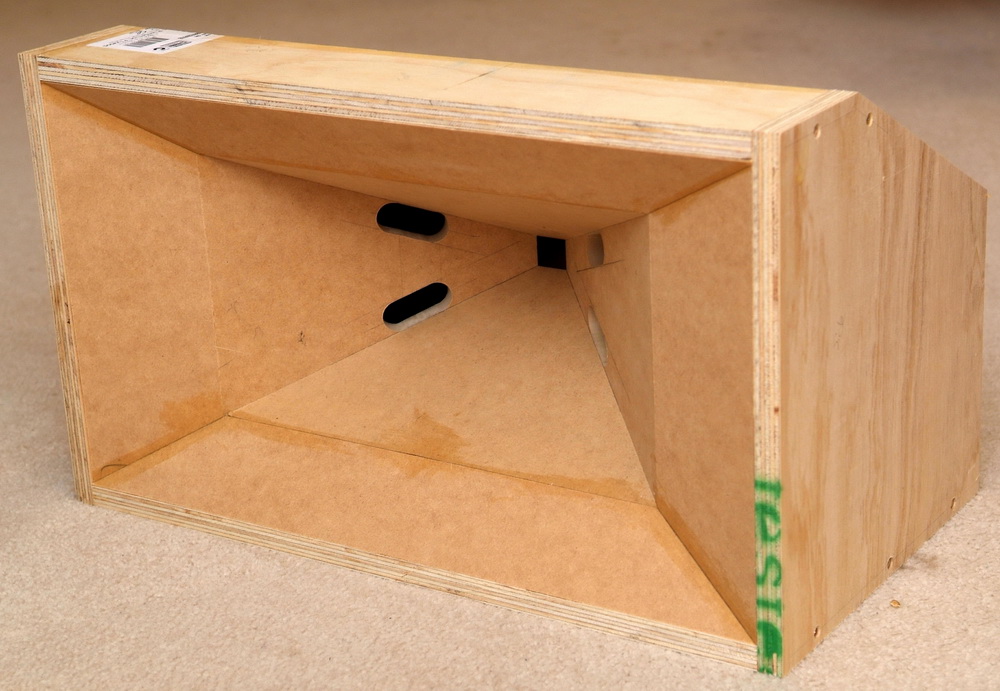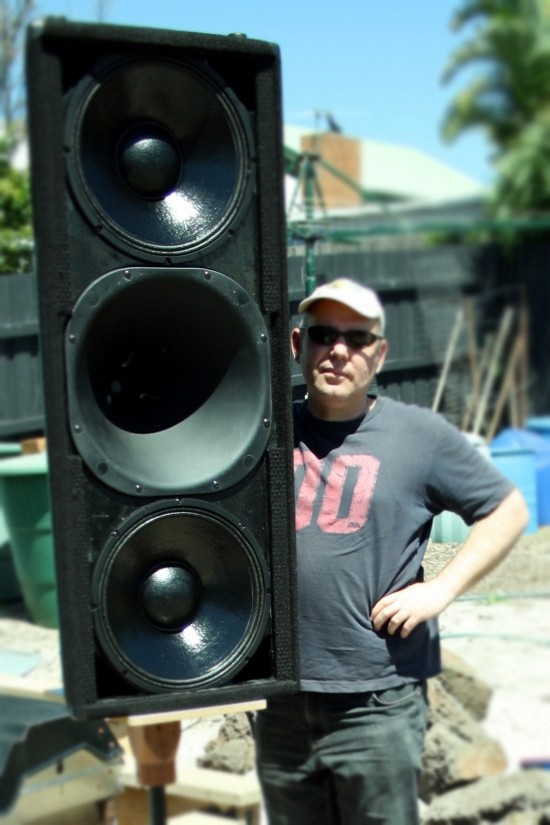3 different tweeters on the integrated smallsyn
Black is with the Tymphany tweeter, red is with the Celestion CDX1-1445 tweeter; Green is with the DNA360

Here are the Tymphany and the mids mounted together; then the Celestion and the mids; then the DNA360 with mids:



Looks like the DNA360 is the clear winner, and should be the easiest crossover to design
Black is with the Tymphany tweeter, red is with the Celestion CDX1-1445 tweeter; Green is with the DNA360

Here are the Tymphany and the mids mounted together; then the Celestion and the mids; then the DNA360 with mids:



Looks like the DNA360 is the clear winner, and should be the easiest crossover to design
Yeah, it could reach to the two Faital woofers on this, but then I couldn't do my waveguide-to-array fade trick.
Ah, excellent point.
If I remember how this works:

The beamwidth of a Danley SH95 or an SPL runt is dictated by the diameter of the horn

A speaker like yours works lower. Basically the Synergy horn controls directivity down to the cutoff of the waveguide. But the array of woofers that surround it take that down to a lower level.
Basically the Synergy horn controls directivity down to the cutoff of the waveguide. But the array of woofers that surround it take that down to a lower level.
That's the general idea. Of course it only takes it down in the horizontal. I guess I could put two more woofers, above and below, to get vertical, too. But then the cabinet has to be so big and I'm going for living room worthy, not giant home theater. Can't get comfortable in a home theater (and besides I'll never have one, no room).
Last edited:
Paraline + Synergy line source seems tempting...
I dunno, I've never seen a frequency response curve from a Paraline that looks like anything approaching high fidelity!
that's certainly the question
is the high frequency response roughness an essential consequence of the folding - or can it be managed/mitigated with close tolerance waveguide design respecting a OS? expansion ratio throughout
rather than the straight conical expansion from building from stack flat sheet stock
if I get focus and brain cells online again I hope to learn ABEC, try a few sims
is the high frequency response roughness an essential consequence of the folding - or can it be managed/mitigated with close tolerance waveguide design respecting a OS? expansion ratio throughout
rather than the straight conical expansion from building from stack flat sheet stock
if I get focus and brain cells online again I hope to learn ABEC, try a few sims
Does the change in compression driver frequence response come from how they are constructed, a minor difference in throat length? Just wondering as the Tymphany and Celestion are almost the same but the DNA measurement shows some changes in the midrange too, which I thought would be the same on all three?
The distance from diaphragm to throat is longer on the DNA360 (and other DE250 type design drivers) than on the Tymphany and Celestion. That's one of the attractions of the Tymph and Celest for Synergy type horns, it allows the midrange to operate to a higher frequency. But it looks like the DNA360 works better with this horn (which was designed for the Tymphany), for whatever reason.
I think I might've gotten the same midrange curve file into the T and C graphs. I don't think they were exactly the same in the midrange, but were very similar
I think I might've gotten the same midrange curve file into the T and C graphs. I don't think they were exactly the same in the midrange, but were very similar
in the latest horn there are two 0.55" ports per mid driver, but as they enter the horn they aren't really round anymore (come in at an angle). The wall thickness (port length) isn't uniform all around either. I also put in a plug to reduce the front volumes.
That first divot around 2300Hz in the tweeter response is due to the mid ports
That first divot around 2300Hz in the tweeter response is due to the mid ports
Looking a little closer, that 2300Hz divot is actually a reflection off the woofer ports, I had taped over both before and just assumed it was from the mid ports. When the woofer ports are covered, there is an upward peak there (also there when measured horizontally off-axis, so treatable). How's that for coincidence? I played with small deflectors and some cotton absorber in the ports, both of which turned the "divot" back into a "bump". I should be able to get away with stuffing a little in the ports without affecting bass response too much, but not sure if it matters as the divot is only there when directly on-axis and it's narrow anyway.
This thing is looking very good so far. Another print to replace the one with the warp is coming off the printer in about 20 minutes. These aren't actually too hard to make, they take a long time to print, but I don't have to actually do anything while it prints other than check on it from time to time (had a couple of filament tangles and a clogged nozzle in earlier prints).
On axis and 22 degrees off-axis (off axis is raised 3dB):

This thing is looking very good so far. Another print to replace the one with the warp is coming off the printer in about 20 minutes. These aren't actually too hard to make, they take a long time to print, but I don't have to actually do anything while it prints other than check on it from time to time (had a couple of filament tangles and a clogged nozzle in earlier prints).
On axis and 22 degrees off-axis (off axis is raised 3dB):

Last edited:
Bill ( re; that 2300hz bump or dip )
JBL uses acoustic foam within the holes ( for the co-entry 6" or 8" mids ) found within the horns of their 3-way Line Array products.
You might try moderating the dip or bump with some acoustic foam .

JBL uses acoustic foam within the holes ( for the co-entry 6" or 8" mids ) found within the horns of their 3-way Line Array products.
You might try moderating the dip or bump with some acoustic foam .
An externally hosted image should be here but it was not working when we last tested it.
Last edited:
I put some Geddes foam (the reticulated stuff he uses) into the ports, but it wasn't thick enough and didn't have enough effect at the frequency. Perhaps some higher ppi stuff might do it, or just I might try making a deflector with cotton insulation. Or maybe just not worry about it for a while
I put some Geddes foam (the reticulated stuff he uses) into the ports, but it wasn't thick enough and didn't have enough effect at the frequency. Perhaps some higher ppi stuff might do it, or just I might try making a deflector with cotton insulation. Or maybe just not worry about it for a while
I tried various foam types and basically settled on nothing at all:
1) I tried reticulated foam. Reticulated foam has a very subtle effect on sound; it's the reason that Geddes can use a plug that's nearly a foot deep while still retaining a significant fraction of the high frequencies. Due to it's subtle effect, a fraction of an inch of it does virtually nothing.
2) I tried closed cell foam. This worked, but it costs you a lot of output. It might be worth a try if you have a fairly large array of midranges. But I'm generally using REALLY small midranges and I can't afford to throw away 3dB of output.
More waveguide porn
The second half finished, here are the two parts joined together. They connect essentially perfectly using just 4 screws and nuts, haven't even glued them and they are solid.

One of them still has the slightest bit of warp, I've since added another "raft" when printing so the new one would be flush when mated with another printed that way. But our demanding QC department says the small gap left is "close enough" and can be filled with some hotmelt (saving another roll of filament and 13 hours of printing).

The second half finished, here are the two parts joined together. They connect essentially perfectly using just 4 screws and nuts, haven't even glued them and they are solid.

One of them still has the slightest bit of warp, I've since added another "raft" when printing so the new one would be flush when mated with another printed that way. But our demanding QC department says the small gap left is "close enough" and can be filled with some hotmelt (saving another roll of filament and 13 hours of printing).

2) I tried closed cell foam. This worked, but it costs you a lot of output. It might be worth a try if you have a fairly large array of midranges. But I'm generally using REALLY small midranges and I can't afford to throw away 3dB of output.
This is on the woofers. But I don't think closed cell can work, since air can't pass through. I may go with doing nothing, since a narrow notch that is only directly on-axis isn't really much of a problem. I thought about making the woofer ports all differently placed (so their effects don't sum) but that would make printing more complicated (2 different models) and make the horn less nice looking.\
Surprisingly, the midrange ports don't appear to do much of anything to the tweeter response
Are there other gains compared to the SmallSyns than easier assembly?
Seems that progress here is so fast, that while I have been able to get the main parts of SmallSyns the evolution is starting to tread over it. Only thing that I've had time to make is a sandbox for the kid. Quess I'll keep on watching what you'll come up with while I'm waiting for the timeslot for my hifihobby to appear (in a year or two).
Seems that progress here is so fast, that while I have been able to get the main parts of SmallSyns the evolution is starting to tread over it. Only thing that I've had time to make is a sandbox for the kid. Quess I'll keep on watching what you'll come up with while I'm waiting for the timeslot for my hifihobby to appear (in a year or two).
- Home
- Loudspeakers
- Multi-Way
- 3D printing 1/2 of a waveguide